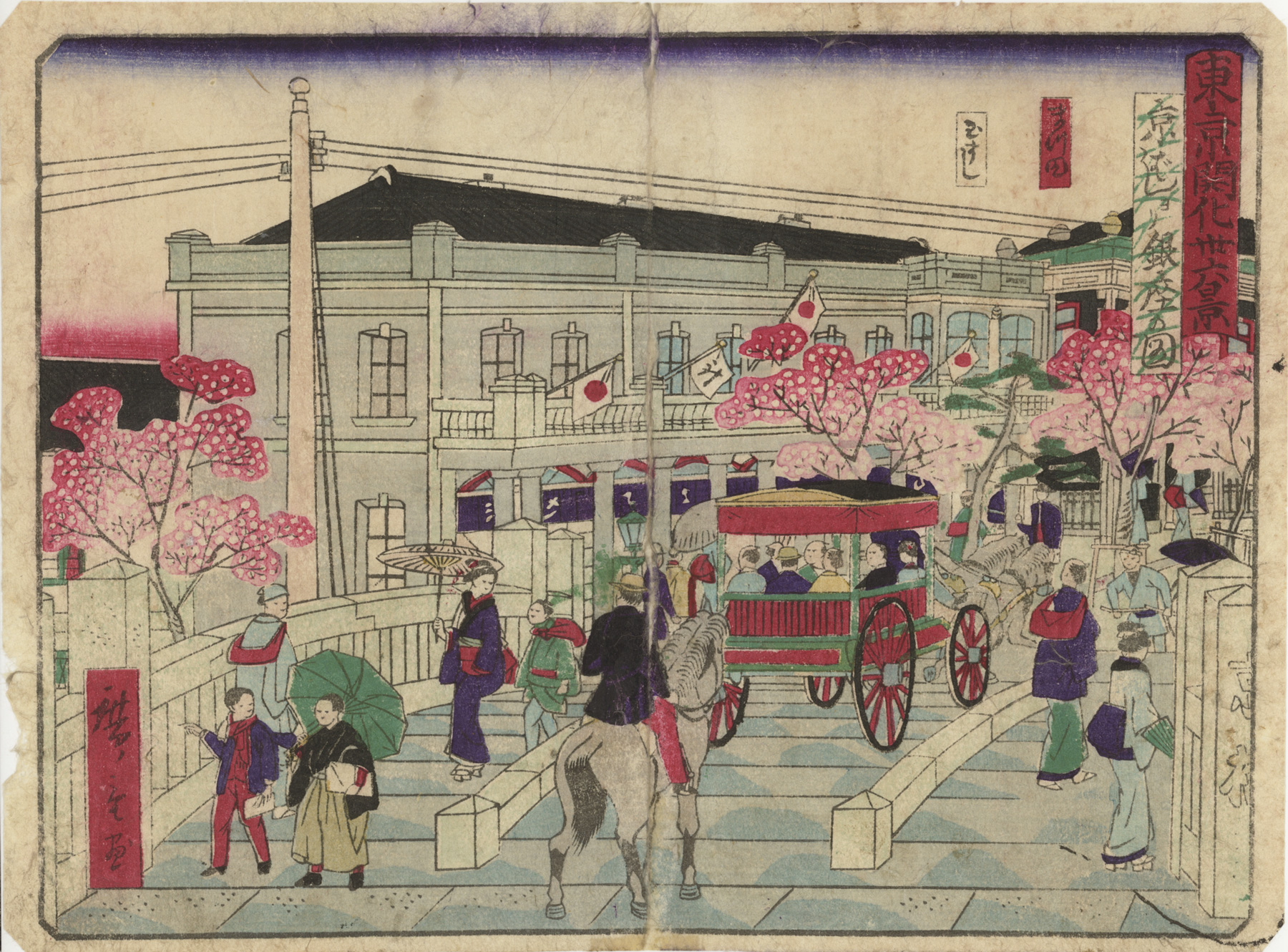About This Print
This 1872 scene presents us with a view from the Kyobashi bridge looking into Ginza Street. A horse drawn carriage crosses Kyobashi bridge within its delimited zone, while pedestrians cross in their designated areas along the sides. A jinrikisha (rickshaw) awaits its turn on the far side of the bridge and a rider on horseback follows the carriage. Kyobashi bridge sat at the east end of Ginza Street and Shinbashi bridge on the west end.
This print has been cut from the original oban-size sheet which also contained the print The Sea off Shinagawa, as pictured below.
Descriptive Information from the Asian Art Museum for San Francisco's 2010 Exhibition
Japan’s Early Ambassadors to San Francisco, 1860–1927
Source: website Asian Art Museum for San Francisco http://www.aamdocents.org/AAM/Japan/Rotation/Painting/b81d24HiroshigeIIIGinzaSteamship.htm
| These two scenes—from a series of views of “modern” Tokyo—reveal how much Japan changed by 1874. Only six years earlier, the government center of Edo had been renamed Tokyo, and a government campaign of “civilization and enlightenment” swiftly transformed the heart of the city. The top scene illustrates several aspects of modernization: a two-story Western-style brick-and-mortar building stands at the far side of Kyobashi (Capital Bridge); a Western-style horse-drawn cart and figures in Western dress cross it; telegraph lines fill the air above. In the lower scene a paddlewheel steamer makes its way through the waters off Shinagawa (a southern neighborhood of Tokyo), an Italian flag flying from the stern. |
Ginza - A Brief History
Source: wikipedia http://en.wikipedia.org/wiki/GinzaAfter the Tsukiji area burnt to the ground in 1872, the Meiji government designated the Ginza area as model of modernization. The government planned the construction of fireproof brick buildings, and larger, better streets connecting the Shimbashi Station and the foreign concession in Tsukiji, as well as to important government buildings. Designs for the area were provided by the Irish-born architect Thomas Waters; the Bureau of Construction of the Ministry of Finance was in charge of construction. In the following year, a Western-style shopping promenade on the street from the Shinbashi bridge to the Kyōbashi bridge in the southwestern part of Chūō with two- and three-story Georgian brick buildings was completed.
"Bricktown" buildings were initially offered for sale, later they were leased, but the high rent meant that many remained unoccupied. Nevertheless, the area flourished as a symbol of "civilization and enlightenment" (bunmei kaika), thanks to the presence of newspapers and magazine companies, who led the trends of the day. The area was also known for its window displays, an example of modern marketing techniques.
三代歌川広重 「東京開花三十六景 京橋より銀座の図 品川沖」 木版画 明治17年
“From Kyobashi to Ginza” and “The Sea off Shinagawa,” from the series Thirty-six Views of Tokyo Civilization, 1874
By Utagawa Hiroshige III (Japanese, 1842–1894)
Meiji period (1868–1912)
Woodblock print; ink and colors on paper
Gift of Mr. Richard Gump, B81D24
Asian Art Museum for San Francisco
“From Kyobashi to Ginza” and “The Sea off Shinagawa,” from the series Thirty-six Views of Tokyo Civilization, 1874
By Utagawa Hiroshige III (Japanese, 1842–1894)
Meiji period (1868–1912)
Woodblock print; ink and colors on paper
Gift of Mr. Richard Gump, B81D24
Asian Art Museum for San Francisco
Print Details
| IHL Catalog | #572 |
| Title or Description | From Kyobashi to Ginza 京橋より銀座の図 |
| Series | Thirty-six Views of Tokyo Civilization 東京開花三十六景 |
| Artist | Utagawa Hiroshige III (1842–1894) |
| Signature | Hiroshige ga |
| Seal | no seal |
| Publication Date | 1874 (Meiji 7) |
| Publisher | Yorozuya Magobei [Marks: pub. ref. 627] Note: publisher's seal is not present on print but multiple sources attribute the publication of this series to Yorozuya Magobei 万屋孫兵衛 |
| Carver | |
| Impression | good |
| Colors | excellent |
| Condition | poor - soiling throughout; vertical paper separation through center of print, repaired from back; other small losses |
| Genre | kaika-e - Meiji era |
| Miscellaneous | |
| Format | Chuban yoko-e |
| H x W Paper | 6 3/4 x 9 1/8 in. (17.1 x 23.2 cm) |
| H x W Image | 6 1/2 x 8 5/8 in. (16.5 x 21.9 cm) |
| Literature | |
| Collections This Print | Asian Art Museum for San Francisco B81D24 (uncut oban sheet as shown above); Chuo, Tokyo City Library 000716914 |
3/27/2020



